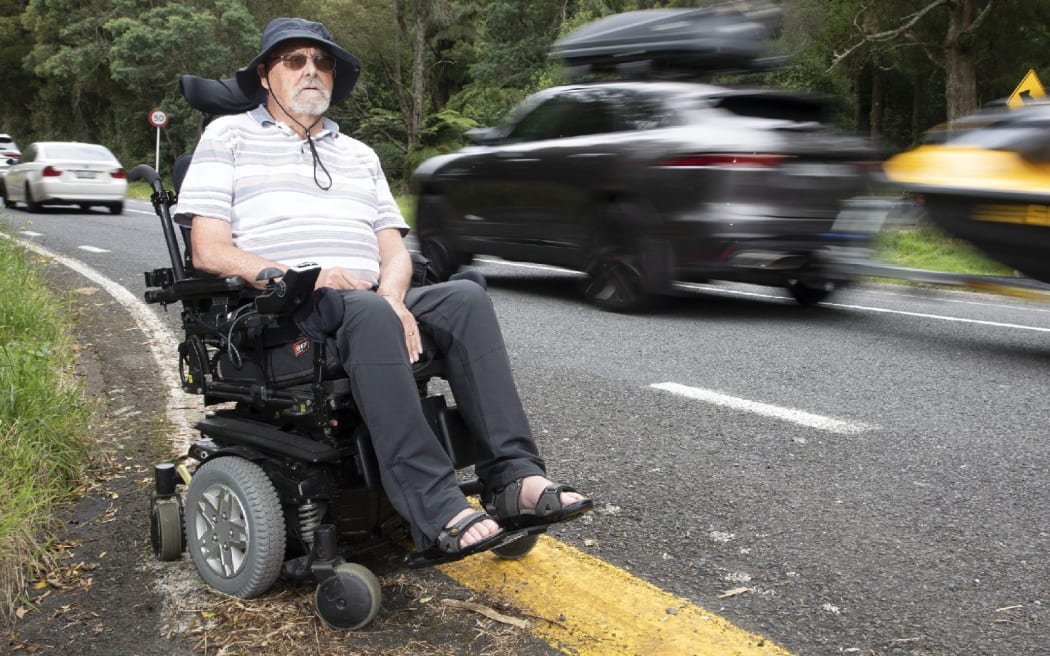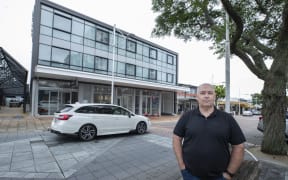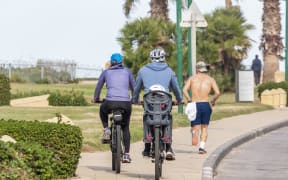
Roger Loveless. Photo: Andrew Warner
By Laura Smith, Local Democracy Reporter
Rotorua resident and accessibility advocate Roger Loveless worries it will take an accident before a footpath is put in near a new subdivision.
The council says there is no priority to build one given the way the road is classified.
Loveless is an electric wheelchair user and says he is dependent on others to visit his family, as the footpath to their home in Redwood Park runs out hundreds of metres before the access point.
There are about 40 lots in the subdivision, many of which are still to be built. But Loveless said there were already families with children living there, including his grandchildren.
He believed vehicles, including trucks, travelled along Tarawera Road above the 50km/h speed limit and it was not safe enough for his grandchildren to walk down to get to school or his house.
Loveless has been involved in various accessibility advocacy groups, including Rotorua Access Group.

He contacted Rotorua Lakes Council on 11 January asking for a safe footpath and cycle route to be constructed along Tarawera Road from Forest Place, where the current footpath ends, to the subdivision 550m further up.
In response, a council staff member said under the Operating District Plan, it was classed as a rural collector road and would not usually be of priority for footpath construction.
They said as building and sub-development continued, the council accepted there may be increasing demand for a footpath from those living in or visiting properties in the park.
Construction could be considered but funding would come from a future Long-term Plan.
Loveless said he was not happy with the response and believed the road should be classed as a peri-urban as per the Waka Kotahi One Network Framework.
"That's the thing that annoys me."
The framework describes a rural connector as a road that links rural roads and inter-regional connectors, an example being a feeder road into a township.
It says a peri-urban road primarily provides access from a residential property on the urban fringe, where the predominant adjacent land use is residential, but usually at a lower density than that found in urban residential locations.
"Even if they said it was two years away, I wouldn't mind as much," Loveless said.
Since receiving that email response, he sent another to council staff asking whether it would take an accident to prove the need for a footpath.
A Waka Kotahi spokesperson said while it set and provided guidance under the One Network Framework, managing the individual road classifications for local roads was the responsibility of respective councils, in this case, Rotorua Lakes Council.
Rotorua Lakes Council infrastructure and environment deputy chief executive and primary CDEM controller Stavros Michael said it shared Loveless' desire for viable, safe and convenient pedestrian/cycling corridors.
He said it was constantly assessing land developments and how these generate demand for new assets and services.
But he said it considered Tarawera Road to be correctly classified within its district plan, as per the Waka Kotahi guidelines.
"Changing the classification would require a District Plan change, a lengthy process that requires community consultation."
Michael said there were many demands on the council's limited financial resources and the appropriate time for rationalising or reviewing these demands and re-prioritising would be during the council's Long-term Plan process.
"This is when the community has the opportunity to submit proposals and elected members evaluate council's ability to invest in such proposals."
The council owns and operates about 1000km of roads, with 75 percent of those in rural areas and 25 percent, or 250km, in urban areas.
In urban areas, there was about 550km of footpaths and shared paths which Michael said indicated a good allocation of accessibility.
"This footpath network continues to be developed in line with council's and community's ability to make further investment through its Long-term Plan."
Lynmore Primary School is the closest to the subdivision, and principal Hinei Taute said she understood the need for the council to prioritise new footpaths, particularly with a number of developments happening around the city.
"They will eventually get to it."
She was hopeful the council would build one at that section of road when there was an "absolute need".
Local Democracy Reporting is Public Interest Journalism funded through NZ On Air.




